Kukai › Longmen Grottoes » Ancient origins
Articles and Definitions › Contents
- Kukai › Who Was
- Longmen Grottoes › Ancient History
Ancient civilizations › Historical and archaeological sites
Kukai › Who Was
Definition and Origins

Kukai or Kobo Daishi (774-835 CE) was a scholar, poet, and monk who founded Shingon Buddhism in Japan. The monk became the country's most important Buddhist saint and has been credited with all manner of minor miracles. Noted as a gifted sculptor and the inventor of Japanese writing, he also created the most important pilgrimage route still followed by believers today.
EARLY LIFE
Kukai was born in 774 CE to a family by the name of Saeki in Sanuki Province, Shikoku which had been exiled from the capital Heiankyo (Kyoto). He adopted the name Kukai, meaning 'air-sea' when he joined, still a youth, a Buddhist monastery. When just seven years old, he was said to have climbed a mountain and, at the summit, declared, "If I am destined to serve the Law, let me be saved, otherwise let me die" (Ashkenazi, 202). He then threw himself off the cliff but was indeed saved by a group of passing saints or arhats who caught the boy and gently lowered him to safety. In another legend, when he was ordained as a priest the morning star descended and jumped into his mouth, a sign that Kukai was a saint and destined for great things.
In a more historically reliable account of Kukai's early life, he was taught the Chinese classics and poetry by his uncle and entered into a Confucian college in the capital in 791 CE. There he encountered a monk who first raised his interest in Buddhism by revealing a technique of repetition to better remember texts. The young man decided to join the priesthood, and his deliberations on the merits of the three main schools of thought - Buddhism, Confucianism, and Taoism - are set out in his Indications, a fictional discussion, written c. 798 CE, between three men, each one representing one of the three branches of philosophy. Needless to say, the Buddhist is the more convincing of the three.
IN SHINGON BUDDHISM, THOSE WHO GAVE UP THEIR WORLDLY LIFE & RESIDED IN A MONASTERY COULD KNOW THE BUDDHA & SO ACHIEVE ENLIGHTENMENT.
SHINGON BUDDHISM
Kukai's studies of Chinese classics at the capital allowed him to visit China as part of a diplomatic embassy between 804 and 806 CE. He studied there under the master Hui-kuo, abbot of the Ching Lung (Green Dragon) Temple, was chosen as the master's successor and was suitably initiated. Thus he became an advocate of esoteric Buddhism or mikkyo, which meant that only the initiated, only those who gave up their worldly life and resided in a monastery, could know the Buddha and so achieve enlightenment.
The Shingon (or 'True Word') Sect which Kukai studied in China (there known as Quen-yen) had made its way from southern India. It held that Buddhist teachings came from the cosmic Buddha Mahavairocana (Dainichi to the Japanese). In particular, the works of Kukai, such as the Shorai Mokuroku ('A Memorial Presenting a List of Newly Imported Sutras'), stipulated that ideal leadership should not be based on Confucian principles, as was hitherto the case, but on the teachings of the Buddha which would be revealed to an emperor on his succession following certain esoteric initiation rites. Consequently, priests, with their privileged knowledge, had the highest status in the state according to Kukai, higher even than emperors.
Crucially, Shingon Buddhism proposed that an individual could achieve enlightenment in their own lifetime and need not wait for death. Rituals included meditation carried out while the body was held in various postures, sacred hand gestures (mudras), and the repetition of secret formulas or mantras. Great importance was given to the power of prayer.
Despite Kukai's own aristocratic background, he was known to have practised what he preached and lived the life of an ascetic, as reflected in this poem from the Seirei Shu ('Collected Inspirations'), an anthology of his works compiled by his disciple Shinzei:
Valley water - one cup in the morning sustains life;Mountain mist - one whiff in the evening nurtures the soul.Hanging moss, delicate grasses suffice to clothe my body;Rose leaves, cedar bark - these will be my bedding.Heaven's compassion spreads over me the indigo canopy of the sky;The Dragon King's devotion passes round me curtains of white clouds.Mountain birds sometimes come, each singing its own song;Mountain monkeys nimbly leap, displaying incredible skill.Spring flowers, autumn chrysanthemums smile at me;Dawn moons, morning winds cleanse the dust from my heart.(Keene, 187)
In 819 CE the monk created a centre for his esoteric doctrine on Mount Koya (in the modern Wakayama Prefecture). The temple there is still today the headquarters of the Shingon Buddhist Sect. Here educated devotees could reach enlightenment, it was promised, not by the lifelong study of sutras but by viewing mandalas, the stylised visual representation of the teachings of Buddha. Kukai had brought back examples of these paintings from his China trip and they commonly portrayed the Buddha in the centre surrounded by circles or rows of his followers and bodhisattvas. The very act of creating these mandalas was considered a religious rite and so the images were thought to contain the embodiment of the deities they portrayed. In 823 CE, Emperor Saga (r. 809-823 CE) granted the founding of the Toji ('Eastern') temple at Minami-ku in Kyoto, thus indicating that Shingon Buddhism had become an accepted part of the official state religion.
MIRACLES
Kukai also established a route of pilgrimage - the longest and most famous in Japan - which is a 1,600 km (1,000 miles) circuit which stops at 88 temples. Besides these more practical achievements, Kukai was credited with many miracles. Known as a great sculptor - there are still several trees in Japan said to have been sculpted by him into figures from Buddhism - he once cured a dying farmer by using his sickle to sculpt a self-likeness and on another occasion miraculously carved a statue of Yakushi, the Buddha of healing, using only his fingernails. The monk was also adept at creating sources of fresh water where they were most needed and of ridding places of demons and troublesome animals like foxes and snakes. Finally, Kukai is thought to protect any pilgrims following his circuit and he provides for any children born while their parents are on it.
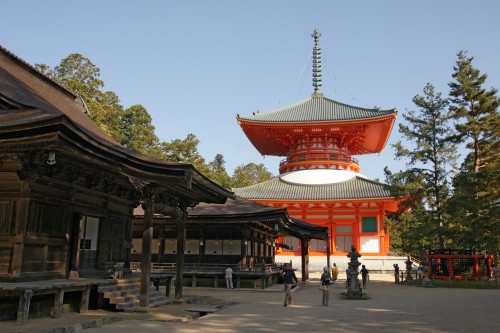
Danjo Garan, Mount Koya
KUKAI THE SCHOLAR
Kukai was, above all, a scholar and he compiled detailed histories of religious thought in both China and India. He wrote the semi-autobiographical Sango shiiki ('Indications of the Goals of the Three Teachings') in 797 CE. Kukai was also a poet of some repute, and he wrote a guide on the rules of Chinese poetry. He was a fine calligrapher, too, and is credited by some (without any evidence) as inventing the kana script, that is Japanese writing using Chinese characters phonetically.
Kukai died in 835 CE - he had predicted the very day - and was buried in a tomb on Mount Koya. After his death, the emperor dreamt that Kukai called to him for a new robe. The emperor acted on the vision and opened up the monk's tomb. Sure enough, there was Kukai looking a little worse for wear in a tattered robe. Freshened up and reclothed, Kukai then made a prediction that the future Buddha, Miroku, would reappear on earth in 5,670,000,300 years. In 921 CE Kukai was given the posthumous title of Kobo Daishi meaning 'Great Teacher of Spreading the Law' by the emperor. The mausoleum of Kukai is today part of the Koyasan temple complex at Mount Koya which is a UNESCO World Heritage Site.
This article was made possible with generous support from the Great Britain Sasakawa Foundation.
Longmen Grottoes › Ancient History
Definition and Origins
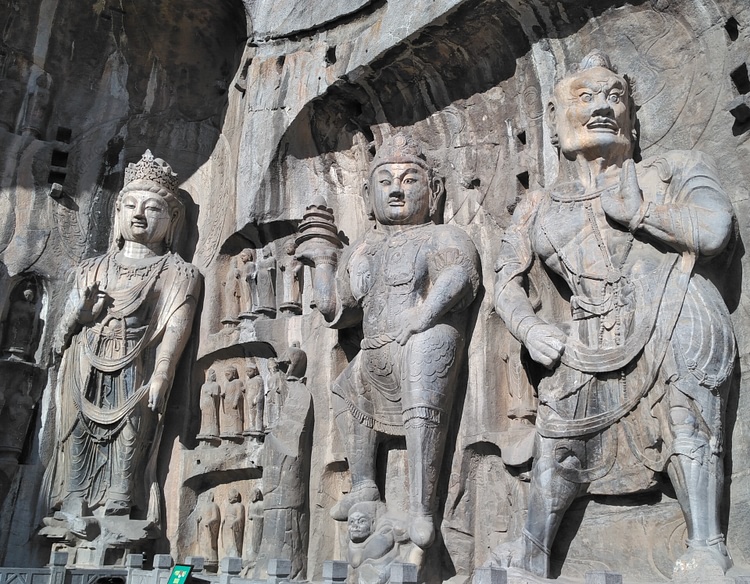
The Longmen Grottoes, a Buddhist cave complex located 13 kilometers south of Luoyang in China ’s Henan province, form some of the most significant and exquisite representations of ancient Chinese stone art. Created over the course of approximately five centuries beginning in 493 CE, these grottoes, along with the statues and inscriptions carved within, provide a window into the political, cultural, and artistic circumstances of the late Northern Wei and Tang periods. The caves were carved into the steep limestone cliffs of Mount Longmen and Mount Xiang which face one another along a one kilometer stretch, forming a valley through which the Yi River flows. This site, with its appearance of a natural gate, was historically referred to as Yique or "Gate of the Yi River." After Emperor Yang of the Sui Dynasty built an imperial palace in Luoyang at the beginning of the 7th century CE with its southern gate aligned to the cliffs of the site, the name Longmen or "Dragon's Gate" came into use (the dragon served as an emblem of the power of the emperor).
LAYOUT
In total, more than 2,300 grottoes and niches, 100,000 Buddhist statues, ranging in size from several centimeters to over 17 meters, and over 2,800 inscriptions were carved into the cliffs at the site, making it the largest such complex in China. A majority of the caves were carved into the face of Mount Longmen, on the west side of the Yi River. Such is the density of grottoes and niches there that they give the cliff face an incredible, honeycomb-like appearance when viewed at a distance.Whereas those grottoes on the west side were used for ceremonies which honored the dead, the caves carved on Mount Xiang to the east were home to a large community of Buddhist monks of various sects.
2,300 GROTTOES & NICHES, 100,000 BUDDHIST STATUES, & OVER 2,800 INSCRIPTIONS WERE CARVED INTO THE CLIFFS AT THE SITE.
REFLECTION OF SOCIETY
The carving of grottoes into remote mountainsides to serve as Buddhist temples was a practice which originated in India c. 3rd century BCE. Buddhism, along with the practice of grotto carving, passed to China along the silk road, influencing the creation of Buddhist grottoes at Yungang near Pingcheng (modern day Datong), the capital of the Northern Wei Dynasty, in the middle of the 5th century CE. When Emperor Xiaowen, who contributed to the carving of the Yungang Grottoes, moved the capital from Pingcheng to Luoyang in 493 CE, he shifted his energy to beginning grotto construction at Longmen.
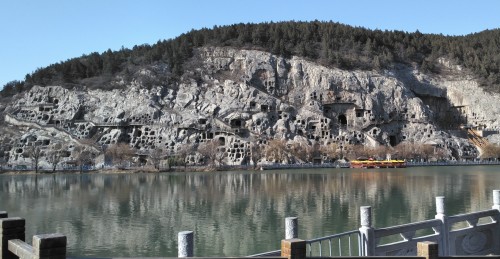
Longmen Grottoes - Mount Longmen
Many of the statues within the oldest grotto carved there, Guyang Cave, were ones which members of the royalty, who followed Emperor Xiaowen to Luoyang, vowed to build. Over 1,000 niches and 800 inscriptions are contained within the cave, making it one of the richest at Longmen and significant as a reflection of the late Northern Wei style of both sculpting and writing. The central statues of Sakyamuni Buddha and two Bodhisattvas (those on the path to enlightenment) each take on a somber appearance and a slender silhouette, contrasting the earlier, broad-shouldered style found at Yungang. Inscriptions attached to statues within Guyang Cave include 19 of the 20 inscriptions designated as exemplary forms of Northern Wei calligraphy and are critical in helping to identify the origins of each work.
After the fall of the Northern Wei Dynasty (535 CE), grotto carving slowed until the formation of the Tang Dynasty (618 CE) – the beginning of a stable and prosperous period marked by significant cultural achievements. During this time, the ascetic style of the Northern Wei gave way to a realistic, dramatic, and intricate style in which some 60% of all grottoes at Longmen were formed. The largest and most magnificent of these is unquestionably Fengxiansi Cave. Carved into the center of the rear wallof the cave is a colossal statue of Vairocana Buddha which, given the quiet elegance and slight smile of the figure, has been referred to as the "Mona Lisa of the East." The Vairocana statue is flanked by a set of disciples and Bodhisattvas, and by a set of heavenly kings and guardians carved into the side walls, forming a semicircle. Given that each statue has a markedly different and yet equally expressive personality, standing at the center of the group, facing the Buddha, is a truly awe-inspiring experience. Completed in 675 CE, the grotto was donated by Emperor Gaozong and Empress Wu Zetian (the first empress regnant in China) to honor their ancestors.
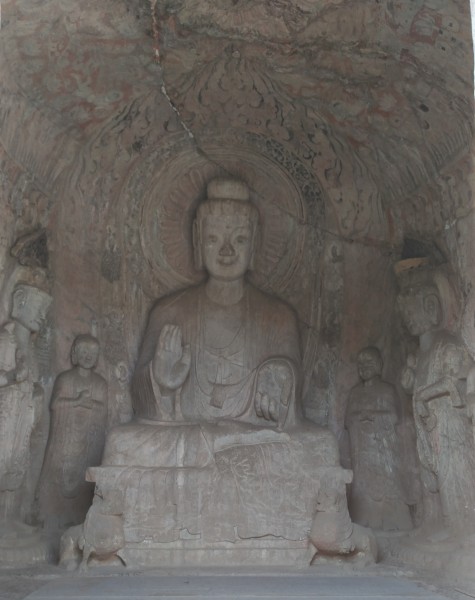
Longmen Grottoes - Middle Binyang Cave
By providing those with sufficient financial resources the ability to dedicate a Buddhist image in order to transfer merit to a named beneficiary, often an emperor or one's parents, statuary art at Longmen ultimately served a spiritual purpose. Patrons of these figures represented a broad cross-section of society – royalty, court officials, military generals, monks, nuns, artisans, laypeople – many of whom included with their donation an inscription describing their motivation for and means of making the commission. By selecting the subject and style of the image, and by conveying their story through the inclusion of an inscription, ancient donors left behind a vivid portrayal of society in the region over a millennium ago.
NOTABLE CAVES
In addition to Guyang and Fengxiansi Caves, several others are particularly worthy of mention. The set of three Binyang Caves (North, Middle, South), carved shortly after the Northern Wei capital was moved to Luoyang, was donated by Emperor Xuanwu in honor of his father, Emperor Xiaowen, and mother, Empress Wenzhao. Unlike figures in Guyang Cave, those in the Binyang Caves are of an earlier Northern Wei style, closer to that found at Yungang Grottoes. Work began on Yaofang Cave in the intervening period between the Northern Wei and Tang dynasties and came to include the engraving of 140 Tang era medical prescriptions – practical remedies to ailments ranging from cholera to hysteria. These treatments, which spread to Japan in the 10th century CE, reveal the degree to which medical science advanced during the Tang Dynasty.
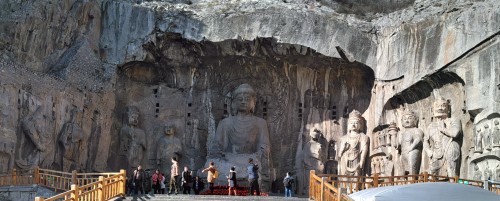
Longmen Grottoes - Fengxiansi Cave
Wanfo Cave, which was completed shortly after the completion of Fengxiansi Cave, was created in honor of Emperor Gaozong and Empress Wu Zetian and purportedly contains 15,000 small, sitting Buddha figures carved within the vast grids of tiny niches which blanket several walls. Prominent patrons of the cave included a female court official and a palace chapel nun.The largest grotto on the east side, Kanjingsi Cave, unlike many other large caves, lacks the grouping of large, carved Buddhist statues. In their place is a procession of life-sized Arhats (those far advanced along the path to enlightenment) stretching around the perimeter of the cave, each with a unique expression, carved in relief in the evocative and highly-detailed style found at other Tang era grottoes.
PRESERVATION
One can only imagine the splendor of the grottoes at Longmen during the Tang Dynasty, with thousands of recently completed carvings painted in a brilliant array of colors. Unfortunately, a number of natural and human forces have detracted from, although in many cases by no means destroyed, the intention of the original artists. Among the natural causes of damage are corrosion due to acid rain, wear from wind exposure, and naturally occurring fissures of the limestone, exacerbated by plant growth and water seepage.
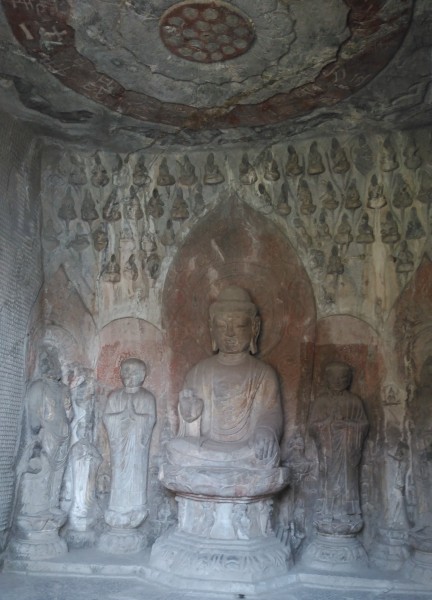
Longmen Grottoes - Wanfo Cave
Although there is evidence that vandalization of the statues had already begun to occur by the 13th century CE, wide-scale looting took place during the early 20th century CE. Looters passed heads and hands of larger figures, or entire smaller figures, to art dealers in Beijing and Xi'an who in turn sold them to foreign art collectors and museums. Restoration of the site did not begin until the establishment of the People's Republic of China, an event which led eventually to refurbishment work on Fengxiansi Cave in 1971 CE. To protect against collapse and water damage, statues were reinforced, original drainage channels were restored, roofs were created above grottoes, and waterproofing was added to statues. In 2000 CE the site was inscribed on the UNESCO World Heritage List.
As with pilgrims of ages past, who visited Longmen to worship or to gain merit through the dedication of a Buddhist image, these grottoes afford modern visitors the chance to take a step closer to the lives of people from a different era, and to stand in wonder at the ability and determination of humankind.
MAP
LICENSE:
Article based on information obtained from these sources:with permission from the Website Ancient History Encyclopedia
Content is available under License Creative Commons: Attribution-NonCommercial-ShareAlike 3.0 Unported. CC-BY-NC-SA License